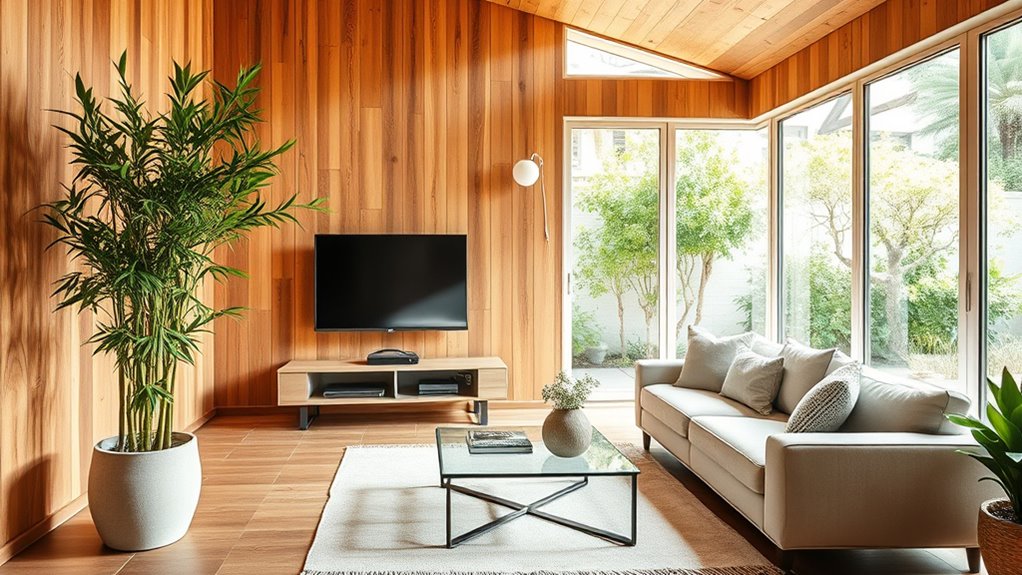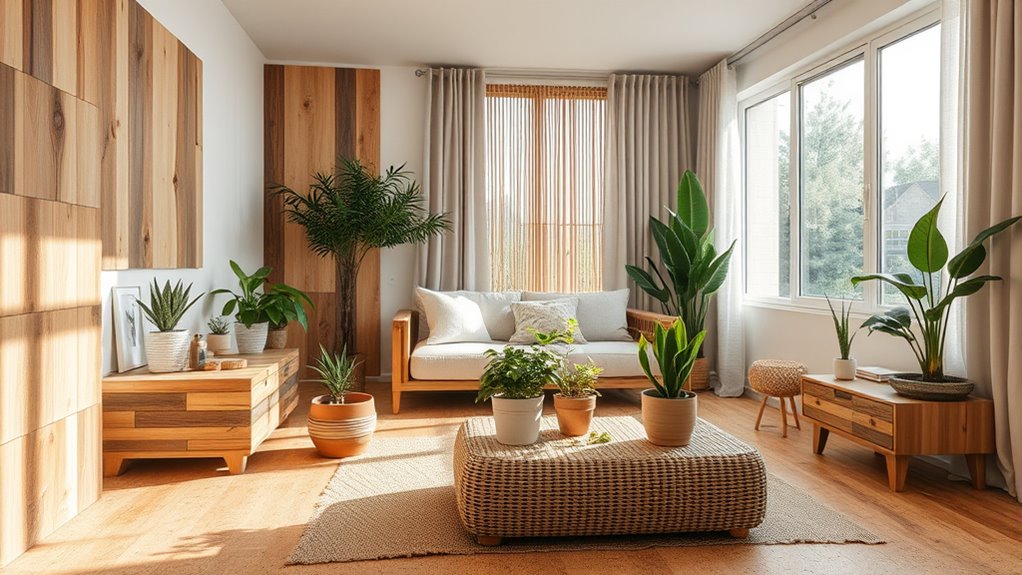Choosing sustainable materials in home design helps reduce your environmental impact while creating healthier, more energy-efficient spaces. Materials like recycled glass, metal, and plastics promote waste reuse, while renewable options like bamboo and cork support eco-friendly harvesting. These sustainable choices often improve insulation, cut energy costs, and enhance indoor air quality. By incorporating eco-conscious materials, you contribute to a greener future—if you continue, you’ll discover more ways to make your home both beautiful and sustainable.
Key Takeaways
- Incorporate recycled, recyclable, or repurposed materials to minimize waste and support a circular economy.
- Use renewable resources like bamboo and cork for sustainable, eco-friendly building and design choices.
- Select materials with superior insulation properties to enhance energy efficiency and reduce greenhouse gas emissions.
- Opt for natural, chemical-free materials to improve indoor air quality and promote healthier living environments.
- Prioritize locally sourced materials to decrease transportation emissions and support sustainable industry practices.

Have you ever wondered how your home design choices can impact the environment? Every decision you make, from the materials you select to the way you manage waste, plays a role in shaping a more sustainable future. One of the most effective ways to do this is by embracing sustainable materials, which prioritize eco-friendly practices like recycling initiatives and the use of renewable resources. When you choose materials that can be recycled or repurposed, you reduce waste and lessen the strain on landfills. Recycling initiatives encourage the reuse of materials such as glass, metal, and certain plastics, making it easier to minimize your environmental footprint. By opting for items that can be recycled at the end of their life cycle, you extend their usefulness and support a circular economy that keeps resources in use longer.
Choosing recyclable and repurposable materials reduces waste and supports a sustainable, eco-friendly home.
Another critical aspect is selecting renewable resources—materials that naturally replenish over time and won’t deplete finite reserves. For example, bamboo is a popular choice because it grows quickly and requires minimal resources to cultivate, making it a highly sustainable alternative to traditional hardwoods. Cork, derived from the bark of cork oak trees, is another renewable material that’s both eco-friendly and versatile for flooring or wall coverings. Using these resources not only reduces your environmental impact but also encourages manufacturers to adopt more sustainable harvesting practices.
Incorporating sustainable materials into your home design can also influence your overall energy consumption. Many eco-friendly materials offer superior insulation properties, which means your home stays warmer in winter and cooler in summer without relying heavily on heating and cooling systems. This lowers your energy bills and decreases greenhouse gas emissions associated with fossil fuel use. Additionally, choosing locally sourced materials reduces transportation emissions, further contributing to your home’s eco-friendliness.
Beyond environmental benefits, sustainable materials often bring aesthetic and health advantages. They tend to be free from harmful chemicals and toxins that can affect indoor air quality, making your living space healthier for you and your family. Furthermore, they can add a natural, timeless beauty to your home, aligning with a minimalist or eco-conscious aesthetic that emphasizes simplicity and harmony with nature.
Ultimately, your choices matter. By prioritizing recycled materials and renewable resources in your home design, you support a more sustainable industry and help conserve our planet’s finite resources. Small changes, like selecting eco-friendly materials and participating in recycling initiatives, can lead to a significant positive impact over time. Incorporating sustainable materials can also foster innovation in construction practices, encouraging the industry to develop new eco-friendly solutions. Your home becomes not just a sanctuary but a statement of your commitment to environmental responsibility.
Frequently Asked Questions
How Do Sustainable Materials Impact Indoor Air Quality?
Using sustainable materials improves your indoor air quality by reducing indoor air pollutants and VOC emissions. These eco-friendly options emit fewer harmful chemicals, helping you breathe cleaner air every day. When you choose sustainable materials, you minimize the risk of respiratory issues and allergies caused by toxic fumes. Overall, sustainable materials create a healthier environment inside your home, making it safer and more comfortable for you and your family.
Are Sustainable Materials Cost-Effective Long-Term?
Think of sustainable materials as the seeds of a money tree—initial costs might seem high, but they grow into lasting savings. You’ll appreciate their durability, which means fewer replacements and repairs over time. This results in significant cost savings, making them a smart long-term investment. By choosing these materials, you’re nurturing a home that’s not only eco-friendly but also economical, helping you save money for years to come.
How Do Sustainable Materials Perform in Different Climates?
You’ll find that sustainable materials perform well across different climates when you choose climate-specific material options. For hot, humid areas, opt for breathable, moisture-resistant materials, while in colder regions, insulative and thermal-efficient options work best. Your regional resource availability also influences performance; using locally sourced, regionally adapted materials guarantees durability and sustainability. By tailoring your choices, you maximize efficiency and longevity in any climate.
Can Sustainable Materials Be Easily Integrated Into Existing Homes?
Integrating sustainable materials into your existing home is like fitting a puzzle piece—challenging but rewarding. You might face renovation challenges, but choosing durable, eco-friendly materials makes the process smoother. These materials often stand the test of time, ensuring longevity and reducing future upgrades. With proper planning and expert guidance, you can seamlessly incorporate sustainability, enhancing your home’s beauty and environmental impact without sacrificing comfort or style.
What Certifications Indicate Truly Sustainable Building Materials?
You should look for eco labels and certification standards to identify truly sustainable building materials. Certifications like LEED, FSC, and Green Seal verify that products meet strict environmental and health criteria. When shopping, check for these eco labels on packaging or product descriptions. These standards guarantee the materials are responsibly sourced, have low environmental impact, and promote healthier indoor spaces, helping you make environmentally conscious choices for your home.
Conclusion
As you explore sustainable materials for your home, remember every choice you make impacts the environment. Imagine the ripple effect of your decisions—creating a space that’s not only beautiful but also responsible. But the true transformation begins when you decide to commit. Will you embrace this change and lead the way toward a greener future? The power is in your hands—what will your next move be? The future of home design is waiting to be written by you.









